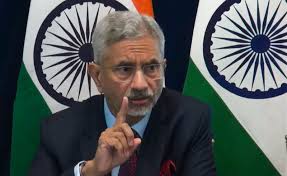Message conveyed with great clarity: Jaishankar on objective of Operation Sindoor

India’s diplomatic strength was once again on display as External Affairs Minister Dr. S. Jaishankar addressed the nation regarding Operation Sindoor, a high-stakes evacuation mission recently undertaken by the Indian government. The operation, launched with precision and urgency, showcased India’s unwavering commitment to the safety of its citizens abroad. With his trademark composure and strategic insight, Jaishankar delivered a clear and compelling explanation of the mission’s objective, underlining the importance of national duty, preparedness, and international cooperation.
What Is Operation Sindoor?
Operation Sindoor is the Indian government’s coordinated mission aimed at rescuing Indian nationals stranded in a conflict-hit or disaster-affected region. Although India has launched similar missions in the past—such as Operation Ganga (Ukraine), Operation Kaveri (Sudan), and Operation Devi Shakti (Afghanistan)—Operation Sindoor stands out for its speed, scale, and clarity of purpose.
The mission was named “Sindoor” to symbolically highlight the cultural connection and the commitment to protect Indian lives, especially women and vulnerable groups. The name evokes a deep emotional resonance, reflecting the government’s prioritization of safety and dignity.
A Swift and Strategic Response
The crisis that necessitated Operation Sindoor unfolded rapidly. With rising tensions and reports of violence in the unnamed foreign country (as per official protocol), the Indian government moved quickly to assess the situation. Within hours, the Ministry of External Affairs, in coordination with Indian embassies and armed forces, devised a detailed evacuation strategy.
Addressing the media, Dr. Jaishankar made it clear that the primary goal was to ensure the safe and swift return of Indian citizens without delay or political interference. “Our first and foremost duty is to protect our people. When Indian lives are at risk, our response must be fast, firm, and focused,” he said.
Clear Communication, Decisive Action
What stood out most during Jaishankar’s briefing was the clarity and confidence with which he conveyed the mission’s objective. In a world often clouded by political rhetoric and diplomatic ambiguity, his statements were refreshingly direct.
He emphasized three key aspects:
- Humanitarian Priority: The mission is grounded in India’s core belief that every Indian life matters—regardless of caste, religion, gender, or economic background.
- Sovereignty and Strategy: While ensuring safety, India also respected the sovereignty of the host nation. Diplomatic permissions and coordination were handled professionally, ensuring that the mission did not escalate existing tensions.
- International Responsibility: India sees such operations not just as national duties but also as contributions to global humanitarian efforts. Jaishankar noted, “Our readiness and resolve reflect not only our responsibility to our citizens but also our role as a trusted global partner.”
Role of Indian Armed Forces and Diplomats
Another significant aspect of Operation Sindoor was the seamless collaboration between the Indian Air Force, Navy, and diplomatic corps. C-17 Globemaster aircraft and special transport units were pressed into action. Commandos accompanied several rescue missions, ensuring security in volatile zones.
Indian embassies worked round the clock, setting up help desks, issuing emergency documents, and liaising with local authorities. Volunteers and Indian diaspora groups also played a vital role in supporting those stranded.
Dr. Jaishankar praised the team effort, stating, “This is a proud moment for India. Our soldiers, diplomats, and support teams worked with precision and heart.”
Challenges on the Ground
Despite the success, Operation Sindoor was not without challenges. Logistical hurdles, damaged infrastructure, volatile ground conditions, and bureaucratic delays in the host country posed significant risks. Yet, the mission adapted swiftly.
One Indian national who returned safely described the operation as “a lifeline in the midst of chaos.” She praised the efforts of embassy officials who guided her through checkpoints, helped her reach the evacuation zone, and ensured her safe return to India.
A Signal to the World
Dr. Jaishankar’s message wasn’t just meant for Indian audiences. It was also a diplomatic signal to the global community: India is prepared, principled, and powerful when it comes to protecting its people.
India’s proactive stance contrasts sharply with the slower response times of some nations in similar crises. This reflects a broader shift in Indian foreign policy—from reactive to proactive, from silent to assertive.
Analysts have noted that Operation Sindoor adds to India’s growing list of successful evacuation operations, boosting its reputation as a responsible global actor capable of crisis management.
Political Unity and Public Support
Interestingly, Operation Sindoor witnessed bipartisan political support. Leaders across party lines praised the government’s timely intervention. Social media platforms were flooded with messages of gratitude from rescued citizens and their families.
Civil society organizations, NGOs, and even celebrities amplified the operation’s success, helping raise awareness and offer support to those still abroad.
This unity in response sends a powerful message of national solidarity during international emergencies.
Looking Ahead: Institutionalizing Evacuation Protocols
While Operation Sindoor has drawn praise, it also brings forth the need for institutionalized evacuation frameworks. Experts suggest that India should now formalize rapid response teams and evacuation corridors in collaboration with other nations.
The Ministry of External Affairs is reportedly working on a blueprint to standardize these operations, ensuring faster deployment in future crises.
Conclusion
Dr. S. Jaishankar’s articulate presentation of Operation Sindoor’s objective reaffirmed India’s core values: responsibility, resilience, and resolve. The mission not only saved lives but also reinforced public trust in the government’s ability to act swiftly and decisively in times of crisis.
By delivering the message with great clarity, Jaishankar ensured that the purpose of the operation was understood at home and abroad—not just as a logistical effort, but as a reflection of India’s evolving global stature.
As the world faces increasing uncertainty, Operation Sindoor stands as a model of how timely diplomacy, strategic action, and national willpower can converge to protect human lives—India’s highest priority.






